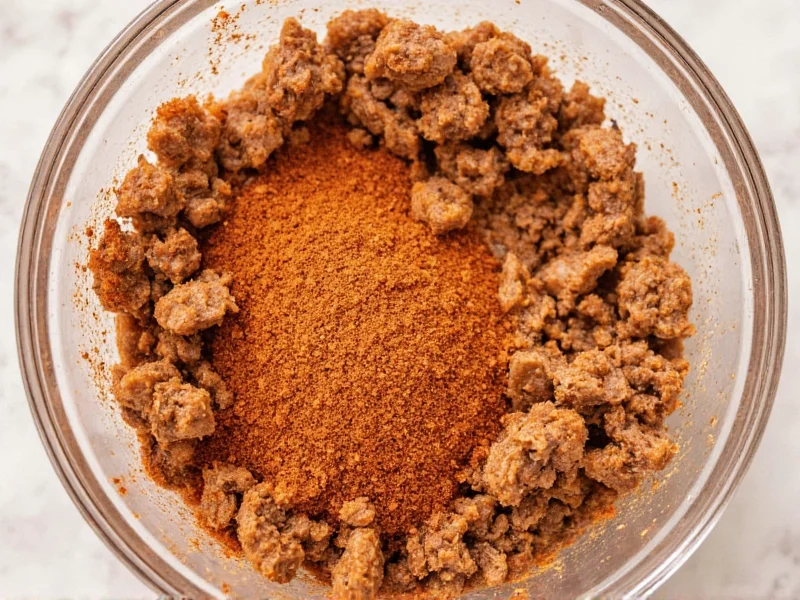Understanding Pork Taco Seasoning's Unique Flavor Profile
Pork taco seasoning differs significantly from standard taco seasoning due to its tailored spice balance designed specifically for pork's rich, slightly sweet flavor. While traditional taco seasoning focuses on bold chili heat for beef, pork seasoning incorporates warmer, earthier notes that enhance rather than overpower the meat.
The ideal pork taco seasoning creates a harmonious balance between:
- Earthy spices (cumin, coriander) that complement pork's natural richness
- Subtle sweetness (brown sugar, cinnamon) to balance pork's fat content
- Controlled heat (ancho chili, chipotle) that enhances without dominating
- Acidic components (citric acid, vinegar powder) to cut through richness
Essential Ingredients in Quality Pork Taco Seasoning
Professional chefs and experienced home cooks agree that the best pork taco seasoning contains these core components in precise ratios:
| Ingredient | Function in Pork Seasoning | Typical Percentage |
|---|---|---|
| Ground cumin | Provides earthy base note that complements pork's richness | 25-30% |
| Smoked paprika | Adds depth and subtle smokiness without overwhelming heat | 20-25% |
| Brown sugar | Counteracts pork's fat and enhances caramelization | 15-20% |
| Garlic powder | Provides savory backbone without raw garlic's sharpness | 10-15% |
| Ancho chili powder | Offers mild heat with fruity undertones | 8-12% |
| Onion powder | Enhances overall savory profile | 5-8% |
| Citric acid | Balances richness with subtle acidity | 2-3% |
Why Standard Taco Seasoning Falls Short for Pork
Using regular taco seasoning on pork often results in disappointing flavor because standard blends prioritize:
- Higher cayenne content designed to cut through beef's stronger flavor
- Less sweetness, which works for beef but leaves pork tasting one-dimensional
- Lower earthy spice content that fails to complement pork's natural richness
When seasoning pork, the absence of balancing sweetness and appropriate earthy notes means the meat's natural flavor doesn't shine through. This explains why many home cooks report their pork tacos tasting "flat" or "bland" when using standard seasoning blends.
Perfect Homemade Pork Taco Seasoning Recipe
Creating your own pork taco seasoning ensures freshness and allows customization to your taste preferences. This professional chef-tested recipe yields enough for 4 pounds of pork:
Basic Pork Taco Seasoning Blend
- ¼ cup ground cumin
- 3 tablespoons smoked paprika
- 2 tablespoons packed brown sugar
- 1½ tablespoons garlic powder
- 1 tablespoon ancho chili powder
- 1 tablespoon onion powder
- 1½ teaspoons dried oregano
- 1 teaspoon ground coriander
- ½ teaspoon cinnamon
- ½ teaspoon citric acid or 1 teaspoon vinegar powder
- 1½ teaspoons sea salt
- ½ teaspoon black pepper
Mix all ingredients thoroughly in a bowl, then store in an airtight container away from light and heat. Properly stored, this blend maintains peak flavor for 3-4 months.
Advanced Techniques for Maximum Flavor
Professional chefs use these techniques to elevate pork tacos beyond ordinary:
Marinating vs. Dry Rub Application
For leaner cuts like pork loin, apply the seasoning as a dry rub 30-60 minutes before cooking. For fattier cuts like pork shoulder (ideal for carnitas), create a wet paste by mixing 3 tablespoons of seasoning with 2 tablespoons olive oil and 1 tablespoon lime juice, then marinate for 4-12 hours.
Cooking Method Adjustments
Different cooking methods require seasoning adjustments:
- Grilling: Reduce salt content by 25% as grill marks create natural salt enhancement
- Slow cooking: Increase earthy spices (cumin, coriander) by 20% as long cooking mutes these flavors
- Pan-searing: Add ½ teaspoon cornstarch to prevent burning while maintaining crust formation
Troubleshooting Common Pork Taco Seasoning Problems
Even experienced cooks encounter these common issues when working with pork taco seasoning:
Problem: Seasoning tastes bitter after cooking
Solution: This typically occurs when paprika or cumin burns. Always add dry seasoning to pork after removing from direct high heat, or mix with oil first to create a paste that won't scorch.
Problem: Flavor disappears during slow cooking
Solution: Add half the seasoning at the beginning of cooking and the remaining half during the last 30 minutes to preserve volatile flavor compounds.
Problem: Seasoning creates a muddy flavor profile
Solution: This happens when using old or low-quality spices. Always use fresh spices (replace within 6 months of opening) and toast whole spices before grinding for maximum flavor clarity.
Creative Applications Beyond Traditional Tacos
Pork taco seasoning's versatile flavor profile works beautifully in unexpected applications:
- As a dry rub for roasted sweet potatoes or butternut squash
- Mixed into ground pork for flavorful meatballs or sliders
- Stirred into black bean soup for southwestern flair
- Combined with mayonnaise for a quick taco-flavored spread
- Used as a seasoning for pork-based pizza toppings
Storage and Freshness Tips
To maintain optimal flavor in your pork taco seasoning:
- Store in an airtight container away from light and heat
- Use dark glass or opaque containers rather than clear plastic
- Label with preparation date and use within 4 months
- Refresh older blends by adding 10% fresh spices to revive flavor











 浙公网安备
33010002000092号
浙公网安备
33010002000092号 浙B2-20120091-4
浙B2-20120091-4